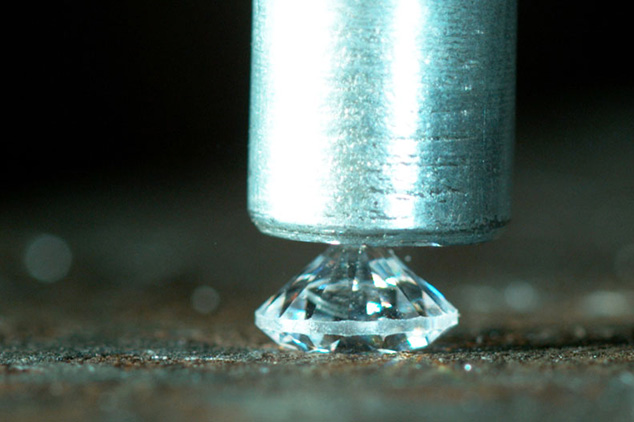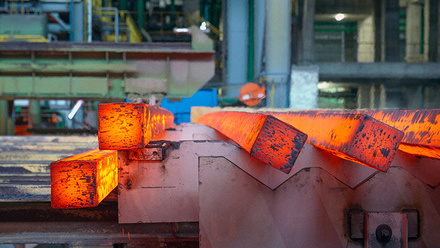Cracking ultra-hard materials
Dr Michael Ford MIMMM at Haseltine Lake Kempner explores a patent for a method to test the hardness/durability of ultra-hard materials.

The hardness of materials is commonly evaluated using macro-, micro- or nano-indentation methods such as the Vickers, Brinell or Knoop hardness tests. These tests generally involve pressing the tip of a tool into a surface of a material sample to obtain a force-displacement curve, from which various mechanical properties can be calculated.
Different tests use different types of indenters and are suitable for characterising different types of material. For example, the Vickers hardness test uses a pyramidal diamond indenter that generally enables more accurate testing of very hard materials, as compared to the steel or tungsten carbide ball indenter of the Brinell test. While the Knoop test is designed for measuring hardness in very brittle materials and thin sheets.
Although a plethora of tests are available, it is currently difficult to evaluate the mechanical properties of ultra-hard materials such as diamond, diamond-like carbon or cubic boron nitride. This is because an indenter typically must be made of a substance harder than the material to be analysed.
Accurate determination of durability against fracture (characterised by a crack initiation load) can also be challenging when the indenter material has a hardness only slightly greater than that of the sample.
Moreover, even single-crystal diamond indenters can be prone to cleavage and low durability when repeatedly used to test the hardness of high-performance ceramic materials. Given the ever-increasing demand for miniaturised, high-accuracy and high-efficiency electronic and optical devices, which incorporate very hard diamond-like components, this is a problem of growing importance.
In May 2023, Sumitomo Electric Industries, Ltd. was granted European patent number EP3667288B1 entitled Indenter comprising polycrystalline diamond, cracking load evaluation method using same, and evaluation device therefor. The patent claims protection for an indenter made of polycrystalline diamond, with a tip that has a spherical surface with a radius of 10-2,000µm. The spherical surface of the tip is a portion with a roundness (measured according to JIS B 0621) of 0.001µm or more and 0.05µm or less.
The patent also claims protection for a method and an evaluation apparatus, which use this indenter for evaluating the load that cracks a test piece – including a material with a diamond-like crystal structure.
The method involves fixing the test piece at a predetermined location, bringing a tip of the indenter into contact with a surface of the test piece, and applying a load to the indenter in a direction perpendicular to and towards said surface. The applied load is increased with time, and a crack initiation load is recorded when an acoustic emission sensor senses a signal at a frequency that is unique to the material of the test piece, and which is emitted when the surface of the test piece cracks.
According to the inventors, the described indenter and method allow durability against fracture to be evaluated accurately in very hard materials such as diamond.
The spherical surface of the indenter tip has been selected to allow force to be applied uniformly and to reduce the burden on the indenter, allowing a test piece that is identical in quality to the indenter to be reliably evaluated for durability against fracture without indenter breakage.
The polycrystalline diamond used is preferably binder-free nano-polycrystalline diamond, which has been found to be particularly hard and does not exhibit cleavage.
The indenter can be produced by shaping a mixture of non-graphitic carbon material and plate-shaped graphite or diamond at a temperature of 1,500°C or higher, and a pressure of 12-18GPa for 20-24h, thus converting the non-diamond material into diamond and sintering the product at the same time.
The resultant polycrystalline material contains both fine-grained diamond crystals and plate-shaped or particulate coarse-grained diamond crystals, and is resistant to both plastic deformation and cracking.
The patented method of crack initiation load measurement is also designed to avoid the application of unnecessarily high loads that could damage the indenter and reduce the component lifetime. In particular, the inventors claim to have found that the crack initiation load can be easily and precisely determined by detecting a frequency at which the test piece oscillates when the surface cracks.
The patent includes data showing how the crack initiation load was measured for test pieces made of two different types of nano-polycrystalline cubic boron nitride. The results obtained are found to correlate with measurements of cutting strength for ball end mills made of the same two boron nitride materials and used to cut steel.
Results are also provided illustrating use of the indenter to measure the crack initiation load of nano-polycrystalline diamond and various types of single-crystal diamond material.







